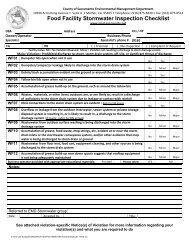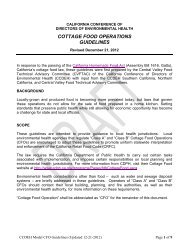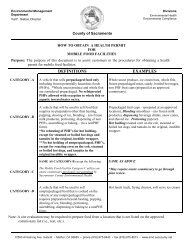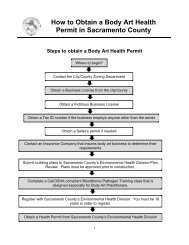California Water Well Standards, DWR Bulletin 74 ... - County of Glenn
California Water Well Standards, DWR Bulletin 74 ... - County of Glenn
California Water Well Standards, DWR Bulletin 74 ... - County of Glenn
- No tags were found...
Create successful ePaper yourself
Turn your PDF publications into a flip-book with our unique Google optimized e-Paper software.
Many cathodic protection wells have been constructed to protect pipelines that transport natural gas or other"hazardous" materials. The Natural Gas Pipeline Safety Act, Public Law 90-481 adopted by Congress inAugust 1968, provides requirements for cathodic protection <strong>of</strong> certain pipelines.Most cathodic protection wells in <strong>California</strong> are located in areas where underground pipelines or "conveyance"systems are numerous and must be protected. These areas include:.South.Oil-producingcoastal region from San Diego to Santa Barbara,.San Francisco Bay Area.areas <strong>of</strong> the southern San Joaquin Valley and the Central Coast, and,Few cathodic protection wells exist in <strong>California</strong> north <strong>of</strong> Sacramento.Many cathodic protection wells, as illustrated in Figure 6, have been constructed by:(1) Drilling a 6- to 12-inch diameter borehole to a desired depth. Cathodic protection wells normally rangefrom 100 to 500 feet in total depth. A few wells have been constructed to depths <strong>of</strong> 800 feet.<strong>California</strong> <strong>Water</strong> Code Section 13711 defines a "cathodic protection well" as an anode installationexceeding 50 feet in depth. Installations less than 50 feet deep are "legally" considered "shallow anodes,"not cathodic protection wells. Shallow anode installations are not specifically covered by these standards.(2) Placing a string <strong>of</strong> anodes in the borehole within a designated interval, usually referred to as the "anodeinterval."(3) Backfilling the anode interval around the anodes with an electrically conductive material, such asgranular coke.(4) Installing a small-diameter vent pipe that extends from the top <strong>of</strong> the anode interval to land surface, orabove. The purpose <strong>of</strong> the vent pipe is to release generated gases. Medium to large-diameter pipe orcasing used in water wells to maintain the well bore and house pumping equipment is not normally usedfor cathodic protection wells.(5) Backfilling the annulus between the vent pipe and borehole wall with an electrically non-conductive fillmaterial to a specific height above the anode interval. Such fill material usually consists <strong>of</strong> uniform,small-diameter gravel. Its purpose is to provide a permeable medium for migration <strong>of</strong> gases and tostabilize the walls <strong>of</strong> the borehole.In the past this material was sometimes used to fill the annulus between the vent pipe and the boreholewall from the top <strong>of</strong> the anode interval to land surface. These standards require specific interval(s) <strong>of</strong>the upper annular space <strong>of</strong> a cathodic protection well be filled with sealing materials instead <strong>of</strong> gravel,to protect ground water quality.(6) Sealing the annulus between the vent pipe and the borehole wall, from the top <strong>of</strong> the non-conductiveannular fill to land surface, with sealing material.(7) Installing a permanent cover over the well at ground surface.(8) Connecting the anode leads to the facility to be protected, possibly through an electrical current source..Individual designs <strong>of</strong> cathodic protection wells vary.-60-
















